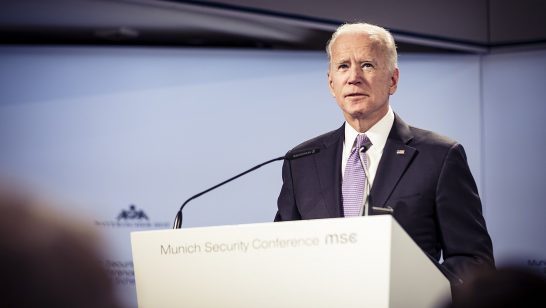
Responding to the need to expunge anachronistic aspects of the deterrence and defense paradigm inherited from the Cold War, this is a proposal for a major shift in U.S. national security policy: an openly announced renunciation and removal from the menu of available U.S. policy options of strategies of mass destruction and strategies that would have mass destruction effects. All actions that would produce massive civilian casualties, also threats to resort to such actions, would be unequivocally forsworn.
The proposed discarding of U.S. Strategies of Mass Destruction (SMD) need not await successful negotiation of a treaty banning nuclear weapons, but it is linked with the current discussion on humanitarian consequences of nuclear weapons use as it will bring U.S. strategies of deterrence and defense into congruence with just war principles and international legal covenants prohibiting attacks on civilians. It will not undermine deterrence. On the contrary, its credibility and the credibility of U.S. extended deterrence commitments will be enhanced if it is known that their implementation will not involve mass-destruction attacks.
The proposal is designed to rectify a fundamental and morally-problematical disconnect at the center of U.S. grand strategy. The counterinsurgency and counterterrorism operations of the United States, including targeted airstrikes, have been substantially constrained by rules of engagement against attacking civilians and noncombatants. Yet, the United States retains a nuclear arsenal capable of destroying tens of millions or more of an enemy’s civilian population – justified by U.S. strategists as necessary to deter the escalation of combat to such holocaust levels. That ultimate deterrence function also remains the standard justification for keeping mutual assured destruction as the criterion for determining the warheads and delivery systems to be retained by the Russians and Americans under the New START formulae for strategic arms reductions.
There is no doubt that the U.S. nuclear strategy and posture have undergone an evolution since the end of the Cold War. Nevertheless, even if the numbers of nuclear weapons are substantially reduced, the crucial moral as well as strategic question will still be: what are their targets? Obama’s doctrinal answer to the targeting question in his 2013 “new guidance” to the Pentagon on the use of nuclear weapons can be read as a step toward a No-SMD policy. That document requires the U.S. military to
maintain significant counterforce capabilities against potential adversaries. The new guidance does not rely on “counter-value” or “minimum deterrence” strategy. The new guidance makes clear that all plans must be consistent with the fundamental principles of the Law of Armed Conflict. Accordingly, plans will, for example, apply the principles of distinction and proportionality and seek to minimize collateral damage to civilian populations and civilian objects. The United States will not intentionally target civilian populations or civilian objects.[1]
However, these admonitions fall short of an unequivocal junking of war plans and threats which — while not “intentionally” targeting civilians, and designed to “minimize” collateral damage – would, if implemented, still kill and maim thousands of noncombatants, even millions under some scenarios.
Perpetuating the existing situation – retaining (and modernizing) a nuclear arsenal that the president may well refuse to resort to in moments of truth, but not admitting it, and letting this be the context of face-offs against America’s WMD-armed enemies – is fraught with risks of fateful miscalculations, which increase the prospect of the United States or its allies and partners one day being attacked with WMD.
The corrective is to be explicit: the United States would announce to the world that it no longer depends on weapons or strategies of mass destruction for any purpose; that they have become anachronistic components of the U.S. military arsenal and grand strategy; that the United States possesses and is enhancing a wide range of capabilities – which it will not be inhibited on moral grounds from using – for punishing and effectively disarming WMD aggressors.
To have any traction, and prospect of adoption by the U.S. government, the no-SMD initiative must address a range of questions as to its desirability and feasibility.
Firstly, would the U.S. adoption of the proposed No-SMD policy destabilize the “balance of terror” that presumably continues to keep U.S. conflicts with Russia and with China below the threshold of direct military engagement? My contention is that U.S. non-nuclear strategies and capabilities can provide the necessary rebalancing, and credible deterrence when developed and given prime strategic roles and missions. And this is based on the assumption that there will be sufficient integration into the force posture of capabilities – such as powerfully concentrated and controllable explosives, electro-magnetic and cyber weapons, increasingly precise guidance – that will make U.S. nuclear strikes, and their unavoidable humanitarian consequences, unnecessary for the accomplishment of any crucial military objective. Whether and when these capabilities could become available, and whether, contrary to current views, “clean” nuclear weapons can be developed, will, of course, affect the feasibility, desirability, and implementation details of the No-SMD move.
A type of destabilization effect of the No-SMD policy worth worrying about is the so-called security dilemma, wherein what one side in a conflict does in order to reduce the tension or threat of violence is interpreted by the other side as an aggressive move rather than a defensive or threat-reduction effort. Particularly insofar as one of the proclaimed purposes of the U.S. No-SMD initiative would be to strengthen the credibility of U.S. extended deterrence and security guarantees to its allies and partners, the Russians and the Chinese are likely to see in it a plan to gain and maintain military superiority over them via major augmentations of U.S. non-nuclear strategic forces. The result: new arms races rather than arms control. Also, if non-nuclear offensive missiles do become America’s strategic systems of choice, nuclear-armed adversaries of the United States might be even more prone than they are now to feel that they must use their most destructive weapons at the onset of a military clash, or risk losing them.
Accordingly, the larger strategy for avoiding dangerous confrontations driven by the security dilemma needs to be focused more on crisis behavior and threats, and on uses of weapons (more than on their possession), whether nuclear, conventional, or unconventional non-nuclear, including cyber — that is, on conflict-resolution diplomacy and on confidence-building measures and routines for assurances that attacks are not imminent.
Secondly, won’t U.S. adversaries– especially those in possession of WMD — be tempted to bully allies and partners of the United States, if not the United States itself? And won’t recipients of U.S. security guarantees regard the public forswearing of mass-destruction strikes as a weakening of the military posture required to back up the extended deterrence commitments?
No. This is not your grandfather’s unilateral disarmament, nor is it an abandonment of robust deterrence or effective defense if deterrence fails. It is a prescription for enhancement of military capabilities which can be more selectively and successfully used than mass-destruction capabilities, and more credibly threatened. Those who would engage in acts of mass destruction against the United States or its allies and partners should be put on notice that they will be severely punished and coercively disarmed, and brought to trial for committing crimes against humanity.
The United States should not allow itself to be provoked into barbaric city-for-city massacres of innocents. It should, rather, be setting an example (which eventually other proud nations will want to follow) of what it means to be a great power.
[1] Report on Nuclear Employment Strategy of the United States Specified in Section 491 of 10 U.S.C. (Department of Defense Publication, June 12, 2013), pp. 4-5.
The opinions articulated above represent the views of the author(s), and do not necessarily reflect the position of the European Leadership Network or any of its members. The ELN’s aim is to encourage debates that will help develop Europe’s capacity to address the pressing foreign, defence, and security challenges of our time.



